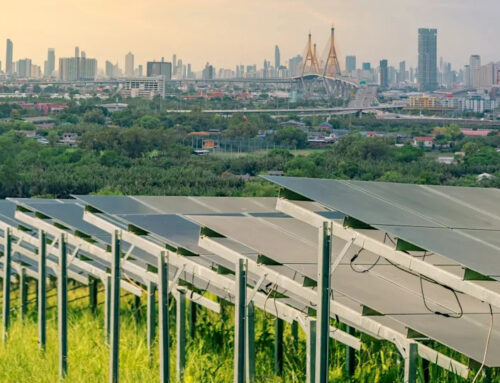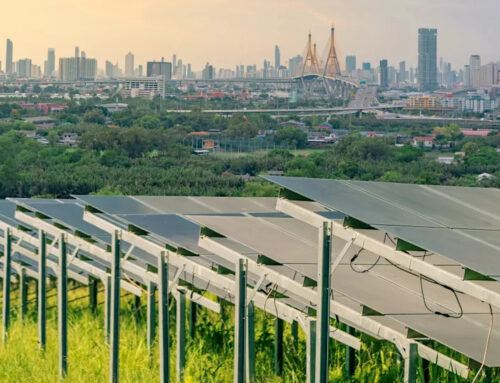Powering the Silicon Island: Can Taiwan Keep the Lights On for AI?
October 6, 2025
Written by Ashley Cheng.
Image credit: 02.13 總統視察「中鋼公司再生水系統及節能措施」by 總統府/ Flickr, license: CC BY 2.0.
Taiwan just pulled the plug on its last nuclear reactor in May 2025, dismantling the one stable source it desperately needed. Taiwan has made a bold political and economic choice, but is the island ready for the consequences? Taiwan currently stands at a critical intersection that will impact its future within the national and international spheres. This de facto independent state is a global leader in semiconductor production and the hub for an increasingly AI-driven global economy. Yet, it faces a looming energy crisis that threatens to undercut its ambitions. With advanced chip fabrication facilities and artificial intelligence (AI) data centres requiring stable and significant energy supplies, Taiwan’s electricity demand is skyrocketing. Simultaneously, its transition to secure, carbon-free energy sources and alternative energy supplies is moving at a dangerously slow pace, unable to develop at the same rate as the AI boom. Ultimately, Taiwan’s current energy trajectory is incompatible with its high-tech goals. Unless Taiwan vigorously accelerates its clean energy transition, it risks energy bottlenecks that could impact not just its climate crisis but also threaten both its national security and economic competitiveness.
Taiwan’s economy is anchored in advanced manufacturing, particularly semiconductors. Taiwan Semiconductor Manufacturing Company (TSMC) alone produces over 90% of the world’s most advanced chips. As global demand for high-performance and AI computing grows, the pressure on Taiwan to deliver more capacity and power rises. Since TSMC’s fabrication plants (fabs) are energy-intensive, its electricity consumption accounted for 6% of Taiwan’s total usage in 2021. This rate is projected to double by 2025 because LNG expansion projects are planned to come online in Kaohsiung and Taichung. This escalating energy demand from high-density cloud computing and AI data centres is compounding this pressure and hindering the high-tech boom. Compared to 2023, AI-related workloads could drive global data centre electricity reliance up 50% by 2027 and 165% by 2030. Taiwan is not exempt. New AI computing hubs in Taipei and Hsinchu are being activated, which all require uninterrupted, high-wattage power supply, something Taiwan’s current grid is ill-equipped to guarantee.
Taiwan’s energy system is currently vulnerable. The island imports roughly 97% of its energy, mainly in the form of liquefied natural gas (LNG), oil, and coal. This reliance on fossil fuel imports leaves Taiwan exposed to geopolitical disruptions from China and economic coercion in cross-Strait relations. Adding to this fragility, Taiwan’s energy mix is still carbon heavy. As of 2023, over 80% of electricity is generated from fossil fuels, and only about 8% comes from renewables such as solar and wind. Although the government has set ambitious targets such as 20% renewables by 2025 and net-zero emissions by 2050, actual development has lagged significantly behind schedule. Supply chain constraints and public opposition in coastal communities have delayed offshore wind projects. In addition, solar expansion is limited by Taiwan’s dense population and scarce land availability. One of the clearest illustrations of this delay is TSMC’s struggle to power its fabs with clean energy. Despite public commitments to source 100% renewable electricity by 2050, TSMC has only secured a fraction of this energy with power purchase agreements (PPAs), offshore wind, and solar producers. The capacity is simply not ready to meet the tech industry’s scaled needs.
In May 2025, Taiwan’s last operating commercial nuclear reactor, specifically the Maanshan Nuclear Power Plant’s second reactor, shut down, sparking debate among political parties. With concerns over imported fossil fuel reliance and energy stability, the KMT and the Taiwan People’s Party (TPP) strongly oppose nuclear decommissioning and have attempted to revise this policy to keep the nuclear source in commission. Just three months later, in August 2025, Taiwan held a referendum to reopen the Maanshan nuclear plant but failed after falling short of the legally required 5 million “yes” votes, despite majority support. In the event of a PRC blockade in the Taiwan Strait, Taiwan’s independent natural gas reserves would only sustain energy supply for ten days, weakening its national security. Despite electricity demand climbing and fossil fuel dependence growing, the referendum’s outcome highlights the absence of consensus on how Taiwan can bridge the short-term gap between its energy needs and its long-term green transition.
The renewable energy challenge is inevitably both technical and political. In March 2025, Taiwan’s CPC Corp, its state-owned oil and energy firm, signed an initial memorandum of understanding (MOU) with Alaska Gasline Development Corp to purchase liquefied natural gas (LNG), establishing a framework with reliable US exports. Although the deal is not finalised, the Lai administration believes this partnership will diversify the island’s energy sources beyond traditional suppliers and ensure stable and consistent energy security for the future.
Taiwan’s democratic politics make large-scale infrastructure development slow and often contentious. President Tsai Ing-wen’s administration of the Democratic Progressive Party (DPP) had emphasised the renewable transition, but opposition parties such as the Kuomintang (KMT) have criticised the decommissioning of nuclear power plants, arguing that it has increased reliance on imported fossil fuels. After the Fukushima disaster in 2011, public opposition to nuclear energy spiked in Taiwan, leading to the gradual shutdown of most plants and the phase-out of nuclear energy. Civilians had a widespread fear that nuclear power poses significant risks in typhoon and earthquake-prone regions. In 2022, a large island-wide blackout and 313 other power outage incidents created increased talk to reconsider nuclear energy. The 2024 election resurfaced all of these energy debates. The ruling DPP remained committed to phasing out nuclear power but did not have a clear bridge strategy to guarantee energy security in the short term. Even with these policy gaps, the newly elected President Lai Ching-te has struggled to reconcile these energy dilemmas with his party’s green agenda and the tech sector’s expected growth.
To assess Taiwan’s energy crisis, an energy security and strategic autonomy framework can be applied. This approach examines not only the availability and affordability of energy, but also its geopolitical implications in the region. Taiwan’s high dependence on energy imports is a national vulnerability. In the event of a blockade in the Taiwan Strait or a conflict with China, maritime LNG and coal shipments could be interrupted, crippling the energy supply and halting chip production. Given Taiwan’s central role in the global semiconductor supply chain, this is both a domestic issue and an international risk. Therefore, securing energy independence or at least resilience is not just an economic matter, but a national and worldwide security concern. These risks frame the energy question as central to Taiwan’s strategic autonomy, reinforcing the need for rapid diversification toward domestic renewables, grid modernisation, and possible re-evaluation of nuclear power as a transitional energy source.
To align its energy system with its high-tech ambitions, Taiwan must act in multiple arenas. To accelerate renewable deployment, Taiwan must remove bureaucratic barriers and fast-track permits for offshore wind and solar projects. To integrate alternative energy sources, mandating solar installations on new buildings and expanding rooftop solar collection through incentives can produce benefits. Investing in battery storage will allow Taiwan to smooth out fluctuations in solar and wind supply, providing a buffer against instability. Taiwan could also consider small modular reactors (SMRs), which are advanced nuclear energy sources, as a safer and cost-effective form of stable power for key infrastructure. SMRs can provide a consistent and resilient energy source, independent of weather conditions, high-risk environments or geopolitical factors. The US Department of Energy has promoted next-generation nuclear tech with SMRs as a transitional power solution. With its current development, this technology could be viable in a few years. With the US production and export of SMRs, this technology can significantly improve Taiwan’s energy security and potentially mitigate or resolve this crisis. To combat the nuclear power closure, Taiwan’s National Atomic Research Institute (NARI) has recently launched an extensive four-year SMR research project, with a budget of over NT$100 million or US$3.3 million, to invest in these vital resources. With grid modernisation, a decentralised, smart grid system would help integrate intermittent renewables and improve resilience against outages or attacks. If Taiwan embedded SMRs into its grid modernisation strategy, the island would be capable of meeting rising electricity demands while reducing dependence on imported fossil fuels. Reassessing nuclear source options could provide baseload power with less carbon emissions and deflect the scale of public opposition associated with older nuclear designs.
As the AI-fuelled tech powerhouse of the world, Taiwan faces rapidly growing energy pressures. However, its simultaneous transition to clean and reliable energy sources remains too slow to support this strategic objective. The convergence of these trends creates a precarious situation. To sustain its economic miracle and bolster its autonomy, Taiwan must prioritise energy policy as a national security issue, not just a climate problem. Without decisive action, the high-tech future that Taiwan seeks to lead may slip from its grasp due to a failure to harness power. Taiwan must expediently develop new energy-efficient and renewable sources to sustain its dominance in the technology sector and lead the AI revolution.
Ashley Cheng is an undergraduate student at Stanford University, majoring in Political Science on the International Relations & Justice and Law tracks. As a Taiwanese American, she is especially interested in questions of democratic resilience, cross-Strait relations, and the island’s path toward greater security and autonomy. She cares strongly about issues affecting Taiwan’s future and aims to highlight how global challenges from the energy transition to the rise of AI shape Taiwan’s strategic choices.
This article was published as part of a special issue on ‘Stanford Student Commentaries‘.
Search
RECENT PRESS RELEASES
Related Post




